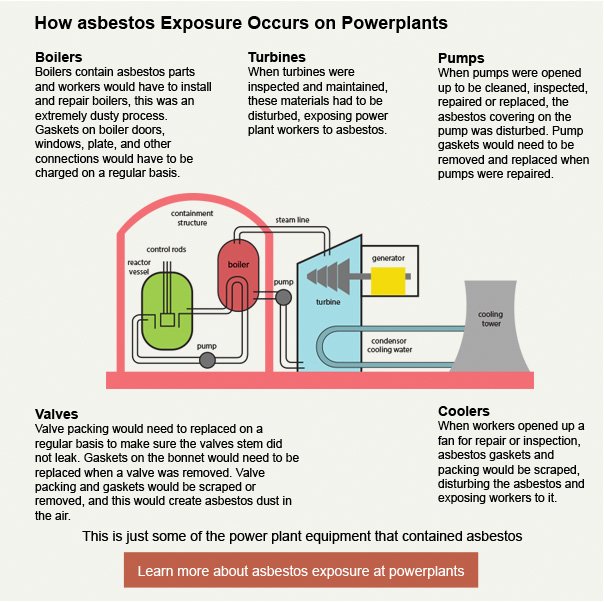LILCO Long Island, New York

Long Island Lighting Company (LILCO) supplied electric and gas services in Nassau and Suffolk counties on Long Island, New York, from 1911 to 1998. It also provided power to Rockaway Peninsula.
At its height LILCO served approximately 2.8 million people over 1,230 square miles. The power utility has played a huge part in the economic growth of Long Island.
Belluck & Fox, LLP represents former LILCO employees who developed mesothelioma and other asbestos-related diseases. Learn more by scheduling a free case review with our mesothelioma attorneys.
Company History
Table of Contents
Long Island Lighting Company was founded by Ellis Laurimore Phillips, an engineer, and a group of New York City investors. It was organized in 1910, merging four small Suffolk County utilities: the Amityville Electric Light Company, the Islip Electric Light Company, the Northport Electric Light Company and the Sayville Electric Company.
As profits increased, LILCO improved its system for generating and delivering electric power with new turbines. The company acquired three companies—the Babylon Electric Light Company, the Suffolk Gas & Electric Light Company and the South Shore Gas Company—from 1915 to 1917.
During World War I LILCO supplied electric service to the U.S. Army at Camp Upton in Yaphank, where draftees first arrived in 1917. With a mind towards accumulating all of its holdings into one company, simplifying rates and standardizing operations, LILCO in 1919 acquired more utilities, and major acquisitions continued through the 1920s.
LILCO converted most of its plants from coal to oil during the 1960s and laid plans for a 450 acre nuclear site in Shoreham. Initial public opposition to the plant over environmental and safety concerns waned in the face of rising petroleum prices stemming from an oil embargo, and construction of the Shoreham nuclear facility began in 1973.
A 1979 accident at the Three Mile Island nuclear reactor in Pennsylvania, however, delayed the Nuclear Regulatory Commission’s (NRC’s) consideration of an operating license for Shoreham to become a nuclear power plant. The Three Mile Island incident also breathed new life into the debate about how Long Island would be evacuated in the event of a similar nuclear catastrophe at Shoreham.
In 1985, a hurricane hit Long Island, creating a massive power outage. The company delayed restoring power for a few weeks, a move that helped end plans for the Shoreham plant and eventually led to the sale of the company. Between the blackout, the fight over Shoreham and rapidly increasing utility rates, public sentiment turned against LILCO.
Support had slowly been growing for a bill to create the Long Island Power Authority (LIPA) to take over LILCO and close Shoreham. The bill passed the New York General Assembly on July 3, 1986, and Governor Cuomo signed it into law.
Federal approval for LIPA to take over LILCO was received in March 1998. In May 1998 LIPA acquired LILCO’s transmission and distribution system. Long Islanders officially became LIPA customers on May 29, 1998. Yet despite the renaming and restructuring of the power company, prior LILCO management, stockholders, employees, property and equipment survived the takeover.
The New York Public Service Commission (PSC) endorsed a wide-ranging settlement in April 1989, and LILCO stockholders approved it that June. Under its terms, Shoreham was fully licensed to operate, transferred to LIPA for $1, and closed.
LILCO and Asbestos Exposure
Exposure to asbestos among power plant workers was widespread due to its use as a thermal insulator in power stations. This exposure is documented through scientific literature as well as through lawsuits filed by former plant employees against companies that provided asbestos without warning of its risks.
In “Asbestos related health hazards among power plant workers” the British Journal of Industrial Medicine, for example, reported that:
- More than 10 percent of insulation workers at a power station in London had an asbestos-related disease.
- Asbestos-related disease among workers in an Italian power plant was more than double the rate expected.
- Asbestos fibers were detected in saliva samples provided by power plant workers. The saliva contained small brown nodules—called ferruginous bodies—that are only found in people exposed to asbestos.
The study found asbestos in the air inside and outside power plants.

Boilers, turbines, pumps, valves, soot blowers, coolers, blowers and fans, compressors, pipes, conveyers, heaters and evaporators were all insulated or packed with asbestos in plants built prior to 1980.
Plant workers that include pipefitters, electricians, maintenance workers, mechanics, boiler operators and tenders, plumbers, welders and laborers were likely exposed to asbestos fibers when they disturbed asbestos-containing materials while installing, inspecting, maintaining, repairing or replacing equipment.
The exposure risk was particularly high for workers who helped convert LILCO plants from coal to oil, as this work also entailed disturbing asbestos-containing materials.
Workers may also have exposed family members to asbestos because fibers can be carried home on clothing.

Asbestos Exposure and Mesothelioma
Airborne asbestos fibers can be inhaled or ingested and attach to linings around the organs, resulting in lung cancer, lung scarring (asbestosis) and mesothelioma.
Asbestos is the only known cause of mesothelioma, a rare cancer that affects organs in the chest and abdomen, most commonly the lungs. Mesothelioma has a latency period of 15-60 years. Meet with a physician if you ever worked at a LILCO plant and are now experiencing the following symptoms:
- Constant coughing, especially with blood
- Breathing problems
- Pain in the chest or abdomen
- Night sweats
- Unexpected weight loss
- Fever
- Fatigue
Diagnosed With Mesothelioma? Know about your Legal Compensation.
 If you are diagnosed with mesothelioma or another asbestos-related disease, you will require compensation for medical bills, lost work time and other costs. Our top asbestos attorneys at Belluck & Fox, LLP is known nationwide for successfully helping asbestos victims and their families.
If you are diagnosed with mesothelioma or another asbestos-related disease, you will require compensation for medical bills, lost work time and other costs. Our top asbestos attorneys at Belluck & Fox, LLP is known nationwide for successfully helping asbestos victims and their families.
Our lawyers have recovered millions of dollars on behalf of New York power plant workers who were put in harm’s way by asbestos companies. We are familiar with LILCO plants and the specific products and areas that exposed workers to asbestos. Visit our office in the City of New York today.
Call Belluck & Fox, LLP at 212-681-1575 or send us an online message to schedule a free consultation.
Specific Power Plants
Port Jefferson Power Plant New York
Years of Operation: 1948-Present
Address: Port Jefferson, New York
The Port Jefferson Power Plant in Brookhaven, New York is an electricity generating station that serves Long Island. It generates 362 megawatts through two natural gas/oil-fired steam-generating units built in 1948 and 1950 by the Long Island Lighting Company (LILCO). Two other units have been in permanent cold standby since 1992.
The Port Jefferson Power Plant is owned by Long Island Power Authority and operated by Public Service Enterprise Group (PSEG). PSEG plans to demolish and rebuild the plant starting in 2018.
Northport Power Station
Years of Operation: 1967-Present
Address: Northport, New York
The Northport Power Station in Northport, New York is a natural gas and conventional oil electric power generating station that serves Long Island. It was built by the Long Island Lighting Company (LILCO) in 1967 and is now part of Long Island Power Authority. It is managed by Public Service Enterprise Group (PSEG).
Northport has four generators that put out 1,522 megawatts. The last one was built in 1977.
Northport Power Station is the largest oil-fired electric generating plant on the East Coast and its outdated technologies have made it a target of environmental groups. In fact, the American Lung Association has given Suffolk County, where the plant is located, air quality grades of “F” for the past 15 years.
A 2014 Supreme Court decision that will permit the Environmental Protection Administration to administer recent Clean Air Act “Good Neighbor” rules may force the plant to modernize because its emissions are contributing to unhealthy ozone levels in states downwind from it.
Glenwood Landing Power Plant
Years of Operation: 1906-2012
Address: Glenwood Landing, New York
The Glenwood Landing power plant in Hempstead, New York provided electricity to Long Island’s North Shore for almost a century. It had four stations originally constructed to burn coal.
Station 1 opened in the early 1900s and was demolished in the 1940s to build a newer station. Station 2, built in the 1920s, was converted to an oil-burning plant in 1963. It was decommissioned in the late 1970s and demolition began in early 2014.
Station 3 (which replaced Station 1) opened in the early 1950s and eventually became an oil and gas plant until oil was phased out in 1991. It was demolished in 2013.
For much of its life, Glenwood Landing belonged to Long Island Lighting Company (LILCO). Long Island Power Authority, which is managed by Public Service Enterprise Group (PSEG), later took over the plant.
E.F. Barrett Power Station
Years of Operation: 1956-Present
Address: Hempstead, New York
The E.F. Barrett Power Station in Hempstead, New York is a natural gas and oil-fired steam electric-generating plant. It is located near the Village of Island Park in Barnums Channel just north of Barnum Island and west of Shell Harbor.
The power station contains two steam units and 12 combustion turbines that collectively generate up to 480 megawatts of power. The steam units became operational in 1956 and 1963 and the turbines began working between 1970 and 1971.
The Barrett Power Station is owned by Long Island Power Authority and operated by Public Service Enterprise Group (PSEG) in New Jersey. It was originally built and owned by the Long Island Lighting Company (LILCO).
Far Rockaway Powerhouse
Years of Operation: 1899-2012
Address: Far Rockaway, NY
The original Far Rockaway, NY Power Station dates to 1899, when it opened as a steam engine generation plant.
In 1953 the Long Island Lighting Company (LILCO) opened a new coal-fired plant at this site. It was later converted to a 109-megawatt natural gas and oil-fired steam electric generation plant and became a gas-only plant in 1966.
The plant was shut down in 1980 and re-opened several years later before it was finally closed in June 2012 by Long Island Power Authority, which took over operations from the financially-troubled LILCO.
Shoreham Nuclear Power Plant
Years of Operation: Completed in 1985, the plant was never fully operation
Address: East Shoreham, NY
The Shoreham Nuclear Power Plant in East Shoreham, NY has never been fully operational.
The Shoreham facility was built by the Long Island Lighting Company (LILCO) between 1973 and 1984 and was intended to provide electrical power for New York residents living in the borough of Queens, as well as in Nassau and Suffolk counties.
In 1979 a nuclear generating station on Three Mile Island (TMI) in nearby Pennsylvania had a partial meltdown. It remains the most significant nuclear energy accident in the U.S. and turned public opinion against nuclear energy.
Following the event at TMI, the Nuclear Regulatory Commission issued regulations for power plants to develop emergency evacuation plans. In 1983 the Suffolk County Legislature rejected LILCO’s evacuation plan for Shoreham. New York Governor Mario Cuomo ordered state power regulatory authorities to reject any LILCO plan.
The Shoreham plant never received more than limited permission from the federal government to run low-powered tests. It was decommissioned in 1989 and its assets purchased by the Long Island Power Authority, created for this specific purpose. In 1992, it became the first commercial nuclear power plant to be dismantled.
Know more about another Power Plant asbestos exposure case happened in Niagara Mohawk Power Corporation and Rochester Gas & Electric.
